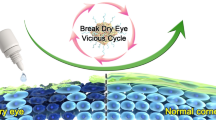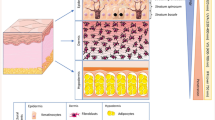Abstract
Background
Trehalose, a nonreducing disaccharide of glucose, is synthesized as a stress response factor when cells are exposed to stressful conditions. In the cornea, oxidative stress plays the key role in the development of acute corneal inflammatory response to UVB rays, photokeratitis. We found previously that trehalose reduced UVB-induced oxidative effects on the formation of cytotoxic peroxynitrite, apoptotic corneal epithelial cell death and changes in corneal optics. The aim of the present study was to examine whether trehalose might inhibit UVB-mediated proinflammatory cytokine and matrix metalloproteinase induction and the development of an antioxidant/pro-oxidant imbalance in the corneal epithelium, changes found previously to be strongly involved in the acute corneal UVB-induced inflammation. The expression of heat shock protein 70 as a potential biomarker for corneal UVB-induced damage was also examined.
Methods
The corneas of New Zealand white rabbits were irradiated with UVB rays, 312 nm, daily dose of 0.5 J/cm2 for 4 days. During the irradiation, trehalose drops were applied on the right eye and buffered saline on the left eye. One day after the end of irradiations, the animals were killed and the corneas examined immunohistochemically for the expression of antioxidant enzymes (catalase, superoxide dismutase, glutathione peroxidase), pro-oxidant xanthine oxidoreductase/xanthine oxidase, proinflammatory cytokines (interleukin-6, interleukin-8), matrix metalloproteinase-9 and heat shock protein 70.
Results
After buffered saline treatment during UVB irradiation, an antioxidant/pro-oxidant imbalance appeared in the corneal epithelium: The expression of antioxidant enzymes was highly reduced, whereas the expression of pro-oxidant xanthine oxidase was increased. The pronounced expression of pro-inflammatory cytokines, matrix metalloproteinase and heat shock protein 70 was found in the UVB-irradiated corneal epithelium. Trehalose application significantly suppressed all the above-mentioned UVB-induced corneal disturbances.
Conclusions
Trehalose favorably influenced the oxidative damage of the cornea caused by UVB rays. Trehalose suppressed proinflammatory cytokine induction. It is suggested that suppression of proinflammatory cytokines contributed strongly to reduced matrix metalloproteinase and xanthine oxidase expression in the UVB-irradiated corneal epithelium and to the decreased development of an antioxidant/pro-oxidant imbalance. The overexpression of heat shock protein 70 found in UVB-irradiated cornea after buffered saline treatment was reduced after trehalose application.





Similar content being viewed by others
References
Wenk J, Brenneisen P, Meewes C, Wlaschek M, Peters T, Blaudschun R, Ma W, Kuhr L, Schneider L, Scharffetter-Kochanek K (2001) UV-induced oxidative stress and photoaging. Curr Probl Dermatol 29:83–94
Koliopoulus JX, Margaritis LH (1979) Response of the cornea to far ultraviolet light: an ultrastructural study. Ann Ophthalmol 11:765–769
Haaskjold E, Olsen WM, Bjerknes R, Kravik K (1993) Early cell kinetic effects of a single dose of narrow-banded ultraviolet B irradiation on the rat corneal epithelium. Photochem Photobiol 57:663–666
Podskochy A, Gan L, Fagerholm P (2000) Apoptosis in UV-exposed rabbit corneas. Cornea 19:99–103
Rogers CS, Chan LM, Sims YS, Byrd KD, Hinton DL, Twining SS (2004) The effects of sub-solar levels of UV-A and UV-B on rabbit corneal and lens epithelial cells. Exp Eye Res 78:1007–1014
Čejka Č, Pláteník J, Guryca V, Širc J, Michálek J, Brůnová B, Čejková J (2007) Light absorption properties of the rabbit cornea repeatedly irradiated with UVB rays. Photochem Photobiol 83:652–657
Tessem MB, Bathen TF, Čejková MA (2005) Effect of UV-A and UV-B irradiation on the metabolic profile of aqueous humor in rabbits analyzed by 1H NMR spectroscopy. Investig Ophthalmol Vis Sci 46:776–781
Fris M, Tessem MB, Čejková J, Midelfart A (2006) The effect of single and repeated UVB radiation on rabbit cornea. Graefes Arch Clin Exp Ophthalmol 244:680–1687
Tessem MB, Midelfart A, Cejkova J, Bathen TF (2006) Effect of UVA and UVB irradiation on metabolic profile of rabbit cornea and lens analysed by HR-MAS 1H NMR spectroscopy. Ophthalmic Res 38:105–114
Cejkova J, Ardan T, Cejka C, Kovaceva J, Zidek Z (2005) Irradiation of the rabbit cornea with UVB rays stimulates the expression of nitric oxide synthases-generated nitric oxide and the formation of cytotoxic nitrogen-related oxidants. Histol Histopathol 20:467–473
Pauloin T, Dutot M, Joly F, Warnet JM, Rat P (2009) High molecular weight hyaluronan decreases UVB-induced apoptosis and inflammation in human epithelial corneal cells. Mol Vis 15:577–583
Cejkova J, Stipek S, Crkovska J, Ardan T (2000) Changes of superoxide dismutase, catalase and glutathione peroxidase in the corneal epithelium after UVB rays. Histochemical and biochemical study. Histol Histopathol 15:1043–1050
Cejkova J, Stipek S, Crkovska J, Ardan T, Midelfart A (2001) Reactive oxygen species (ROS)-generating oxidases in the normal rabbit cornea and their involvement in the corneal damage evoked by UVB rays. Histol Histopathol 16:523–533
Lodovici M, Raimondi L, Guglielmi F, Gemignani S, Dolara P (2003) Protection against ultraviolet B-induced oxidative DNA damage in rabbit corneal-derived cells (SIRC) by 4-coumaric acid. Toxicology 184:141–147
Cejkova J, Stipek S, Crkovska J, Ardan T, Platenik J, Cejka C, Midelfart A (2004) UV Rays, the prooxidant/antioxidant imbalance in the cornea and oxidative damage. Physiol Res 53:1–10
Elbein AD, Pan YT, Pastuszak I, Carrol D (2003) New insights on trehalose: a multifunctional molecule. Glycobiology 13:17R–27R
Minutoli L, Altavilla D, Bitto A, Polito F, Bellocco E, Lagana G, Giuliani D, Fiumara T, Magazu S, Ruggeri P, Guarini S, Squadrito F (2007) The disaccharide trehalose inhibits proinflammatory phenotype activation in macrophages and prevents mortality in septic shock. Shock 27:91–96
Chen W, Zhang X, Liu M, Zhang J, Ye Y, Lin Y, Luyckx J, Qu J (2009) Trehalose protects against ocular surface disorders in experimental murine dry eye through suppression of apoptosis. Exp Eye Res 89:311–118
Jain K, Roy I (2009) Effect of trehalose on protein structure. Protein Sci 18:24–36
Cejkova J, Cejka C, Ardan T, Sirc J, Michalek J, Luyckx J (2010) Reduced UVB-induced corneal damage caused by reactive oxygen and nitrogen species and decreased changes in corneal optics after trehalose treatment. Histol Histopathol 25:1403–1416
Di Girolamo N, Kumar RK, Coroneo MT, Wakefield D (2002) UVB-mediated induction of interleukin-6 and −8 in pterygia and cultured human pterygium epithelial cells. Investig Ophthalmol Vis Sci 43:3430–3437
Nakamura S, Shibuya M, Nakashima H, Hisamura R, Masuda N, Imagawa T, Uehara M, Tsubota K (2007) Involvement of oxidative stress on corneal epithelial alterations in a blink-suppressed dry eye. Investig Ophthalmol Vis Sci 48:1552–1558
Dogru M, Wakamatsu T, Kojima T, Matsumoto Y, Kawakita T, Schnider Ch, Tsubota K (2009) The role of oxidative stress and inflammation in dry eye disease. Cornea 28:S70–S74
Chandler HL, Kusewitt DF, Colitz CM (2008) Modulation of matrix metalloproteinases by ultraviolet radiation in the canine cornea. Vet Ophthalmol 11:135–144
Kim YS, Han JA, Chenong TB, Ryu JC, Kim JC (2004) Protective effect of heat shock protein 70 against oxidative stress in human corneal fibroblasts. J Korean Med Sci 19:591–597
Mosser DD, Morimoto RI (2004) Molecular chaperones and the stress of oncogenesis. Oncogene 23:2907–2918
de la Coba F, Aguilera J, de Gálvez MV, Alvarez M, Gallego E, Figueroa FL, Herrera E (2009) Prevention of the ultraviolet effects on clinical and histopathological changes, as well as the heat shock protein-70 expression in mouse skin by topical application of algal UV-absorbing compounds. J Dermatol Sci 55:161–169
Benaroudj N, Lee DH, Goldberg AL (2001) Trehalose accumulation during cellular stress protects cells and cellular proteins from damage by oxygen radicals. J Biol Chem 276:24261–24267
Tanaka M, Machida Y, Nukina N (2005) A novel therapeutic strategy for polyglutamine diseases by stabilizing aggregation-prone proteins with small molecules. J Mol Med 83:343–52
Béranger F, Crozet C, Goldsborough A, Lehmann S (2008) Trehalose impairs aggregation of PrPSc molecules and protects prion-infected cells against oxidative damage. Biochem Biophys Res Commun 374:44–48
Murphy G, Young AR, Wulf HC, Kulms D, Schwarz T (2001) The molecular determinants of sunburn cell formation. Exp Dermatol 10:155–160
Kolozsvari L, Nogradi A, Hopp B, Bor Z (2002) UV absorbance of the human cornea in the 240- to 400-nm range. Investig Ophthalmol Vis Sci 43:2165–2168
Pappa A, Chen C, Koutalos Y, Townsend AJ, Vasiliou V (2003) Aldh3a1protects human corneal epithelial cells from ultraviolet and 4-hydroxy-2-nonenal-induced oxidative damage. Free Radic Biol Med 34:1178–1189
Halliwell B (1991) Reactive oxygen species in living systems: source, biochemistry and role of human disease. Am J Med 91:14S–22S
Lodovici M, Caldini S, Morbidelli L, Akpan V, Ziche M, Dolara P (2009) Protective effect of 4-coumarin acid from UVB ray damage in the rabbit eye. Toxicology 255:1–5
Marak GEJR, Till GO, Ward PA (1990) Xanthine oxidase generation of toxic oxygen metabolites in acute uveitis. Int Ophthalmol 14:345–347
Nishino T, Nakanishi S, Okamoto K, Mizushima J, Hori H, Iwasaki T, Nishino T, Ichimori K, Nakazawa H (1997) Conversion of xanthine oxidoreductase into oxidase and its role in reperfusion injury. Biochem Soc Trans 25:783–786
Kenedy M, Kim KH, Harten B, Brown J, Planck S, Meshul C, Edelhauser H, Rosenbaum JT, Armstrong CA, Ansel JC (1997) Ultraviolet irradiation induces the production of multiple cytokines by human corneal cells. Investig Ophthalmol Vis Sci 38:2483–2491
Strieter RM, Kunkel SL, Elner VM, Martonyi CL, Koch AE, Polverini PJ, Elner SG (1992) Interleukin-8: a corneal factor that induces neovascularization. Am J Pathol 141:1279–1284
Mo JS, Matsukawa A, Ohkawara S, Yoshinaga M (2000) CXC chemokine GRO is essential for neutrophil infiltration in LPS-induced uveitis in rabbits. Exp Eye Res 70:221–226
Page S, Powell D, Benbouberta M, Stevens CR, Blake DR, Selase F, Wolstenholme AJ, Harrison R (1998) Xanthine oxidoreductase in human mammary epithelial cells: activation in response to inflammatory cytokines. Biochim Biophys Acta 1381:191–202
Komaki Y, Sugiura H, Koarai A, Tomaki M, Ogawa H, Akita T, Hattori T, Ichinose M (2005) Cytokine-mediated xanthine oxidase upregulation in chronic obstructive pulmonary disease´s airways. Pulm Pharmacol Ther 18:297–302
Woessner JF (1991) Matrix metalloproteinases and their inhibitors in connective tissue remodelling. FASEB J 5:2145–2154
Luca M, Huang S, Gershenwald JE, Sing RK, Reich R, Bareli M (1997) Expression of interleukin-8 by human melanoma cells up-regulates MMP-2 activity and increases tumor growth and metastasis. Am J Pathol 151:1105–1113
Franchimont N, Rydziel S, Delany AM, Canalis E (1997) Interleukin-6 and its soluble receptor cause a marked induction of collagenase 3 expression in rat osteoblast cultures. J Biol Chem 272:12144–12150
Bivik C, Rosdahl I, Ollinger K (2007) Hsp70 protects against UVB induced apoptosis by preventing release of cathepsins and cytochrome c in human melanocytes. Carcinogenesis 28:537–544
Simon MM, Reikerstorfer A, Schwarz A, Krone C, Luger TA, Jäättelä M, Schwarz T (1995) Heat shock protein 70 overexpression affects the response to ultraviolet light in murine fibroblasts. Evidence for increased cell viability and suppression of cytokine release. J Clin Invest 95:926–933
Matsuda M, Hoshino T, Yamashita Y, Tanaka K, Mají D, SatoK AH, Sobue G, Ihn H, Funasaka Y, Mizushima T (2010) Prevention of UVB radiation-induced epidermal damage by expression of heat shock protein 70. J Biol Chem 285:5848–5858
Sponsorship information
Supported by grants CZ: AVOZ50390512 and CZ: GA CR: GA P302/10/P155
Statement
The authors have full control of all primary data and they agree to allow Graefes Arch Clin Exp Ophthal to review their data upon request.
Author information
Authors and Affiliations
Corresponding author
Electronic supplementary materials
Below is the link to the electronic supplementary material.
ESM 1
(DOC 25 kb)
Rights and permissions
About this article
Cite this article
Čejková, J., Ardan, T., Čejka, Č. et al. Favorable effects of trehalose on the development of UVB-mediated antioxidant/pro-oxidant imbalance in the corneal epithelium, proinflammatory cytokine and matrix metalloproteinase induction, and heat shock protein 70 expression. Graefes Arch Clin Exp Ophthalmol 249, 1185–1194 (2011). https://doi.org/10.1007/s00417-011-1676-y
Received:
Revised:
Accepted:
Published:
Issue Date:
DOI: https://doi.org/10.1007/s00417-011-1676-y




